NVIDIA GeForce GTX 780 Overclocking Results
by Ryan Smith on May 28, 2013 10:00 AM EST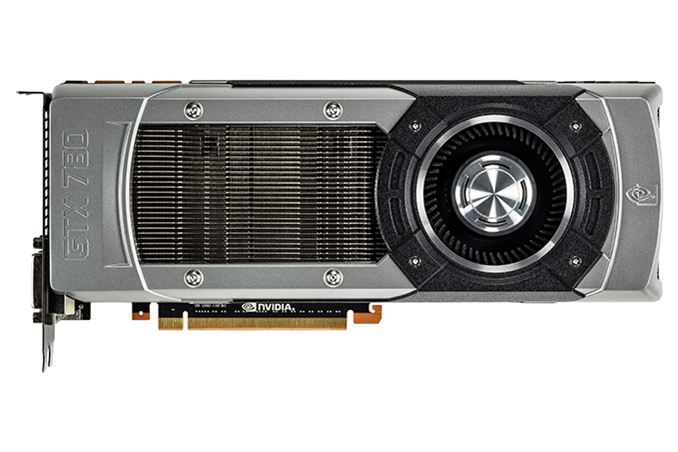
Although we didn’t have enough time to include our GeForce GTX 780 overclocking results in our review of NVIDIA’s latest card, we didn’t want to discard them entirely. Especially not after seeing just how far GTX 780 could overclock. So as an addendum to last week’s review, let’s take a look at GTX 780 overclocking.
When it comes to overclocking, GTX 780 is in an interesting spot. On the one hand it’s already the highest clocked GK110 part, with a base clock of 863MHz, making it the GK110 part closest to any practical clockspeed limits. On the other hand GTX 780 is built against the same power delivery requirements as GTX Titan, with a stock TDP limit of 250W. This is significant because GTX 780 packs a GPU with fewer enabled SMXes than GTX Titan, and perhaps more importantly half as many RAM chips.
So while GTX 780 can’t necessarily clock any higher than GTX Titan, the additional TDP headroom means that it’s more likely to reach its higher boost bins more often, making overclocking more effective. Compounding all of this is the fact that at stock GTX 780 is more often temperature limited than it is TDP limited, amplifying the factor we have the greatest control over (the temperature throttle) and minimizing the factor we have the least control over (the TDP limit).
| GeForce GTX 780 Overclocking | ||||
| Stock | Overclocked | |||
| Core Clock | 863MHz | 1063MHz | ||
| Boost Clock | 902MHz | 1102MHz | ||
| Max Boost Clock | 1006MHz | 1228MHz | ||
| Memory Clock | 6GHz | 7GHz | ||
| Max Voltage | 1.162v | 1.2v | ||
The end result is that while the GTX 780 isn’t going to be an overclocking champion, it’s in a good position to satisfy overclockers. On our sample we’ve been able to push it ahead by 200MHz, moving the base clock from 863MHz to 1063MHz, a 23% improvement. Meanwhile on the memory side NVIDIA’s solid memory controller implementation once more shines through, with our sample easily going from a 6GHz memory clock to a 7GHz memory clock, a 1GHz (17%) improvement.
And what do we get for our efforts? In short, thanks to the fact that GTX Titan is only 11% faster than GTX 780 on average in the first place, GTX 780 can easily exceed Titan’s stock performance when overclocked. Actual scaling depends on the game – not every game scales well with higher clockspeeds alone – but in most games we at least pick up the 17% lower bound that comes with the memory overclock. This means that an overclocked GTX 780 crosses those few 60fps thresholds that the stock GTX 780 fell just shy of, including the minimum framerate in HItman: Absolution, and the average framerate in Crysis 3.
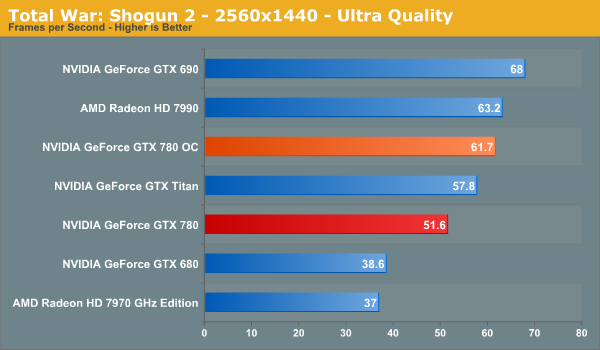
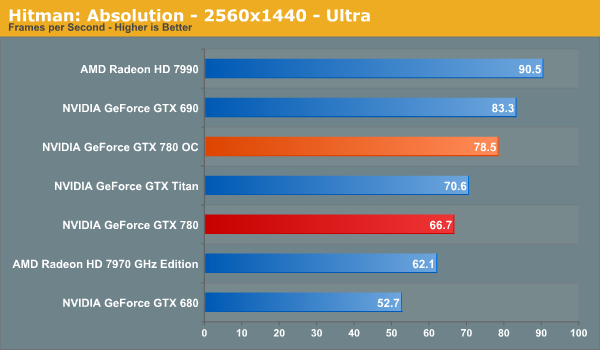

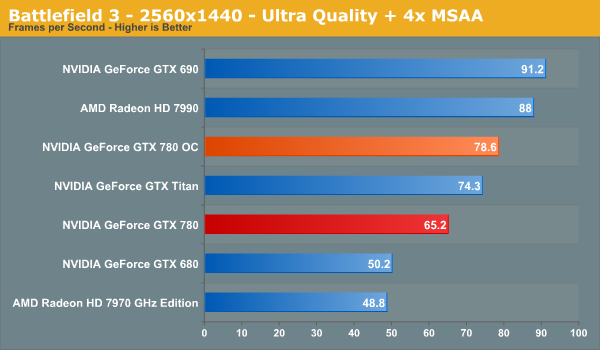

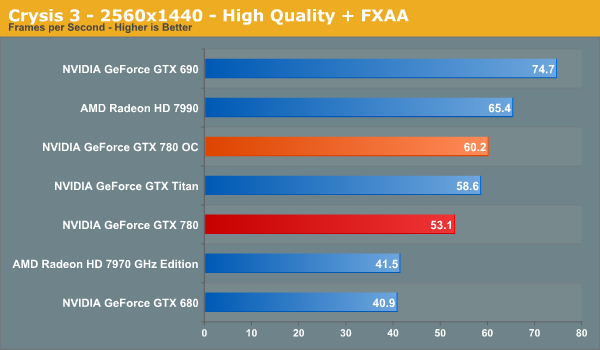
One of the more pronounced outcomes of overclocking the GTX 780 is that we’re essentially exchanging the card’s temperature limit for its TDP limit. Being temperature limited keeps fan speeds down and reduces leakage, but it’s also a limit we have a great deal of control over. Whereas with the TDP limit we can only raise it by 6%, from 250W to 265W, which is immediately consumed by a combination of higher boost bins, higher again boost bins from overvolting, and slightly increased leakage. The end result is that the TDP limit places a rather hard cap on performance, although the ultimate performance limit remains untouched since we can’t completely discard power for performance, leaving the highest boost bins underutilized.
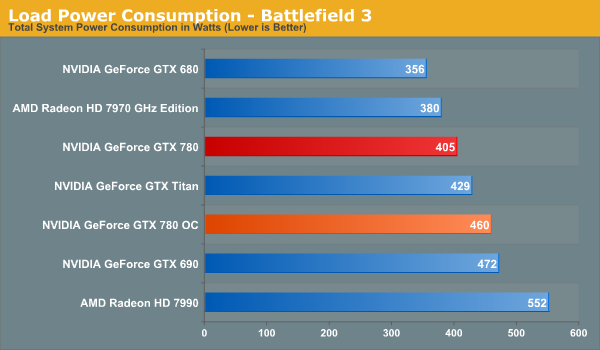
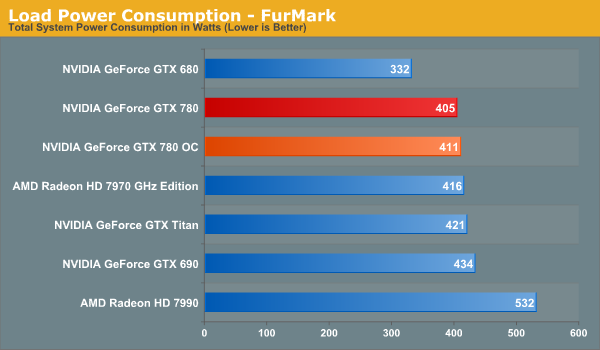
Because GTX 780 is more often temperature limited, and hence running under its TDP, overclocking does come with some pretty stiff consequences for power consumption. Power consumption under FurMark only rises by 6W at the wall since it’s already TDP limited, but in BF3 the difference is 55W at the wall. Some of that is due to higher CPU power consumption as the CPU is tasked with generating more frames, but most of that is from GTX 780 itself. As we saw earlier the performance increase is quite good, but accessing it does mean giving up the GTX 780’s finely honed performance/power ratio.
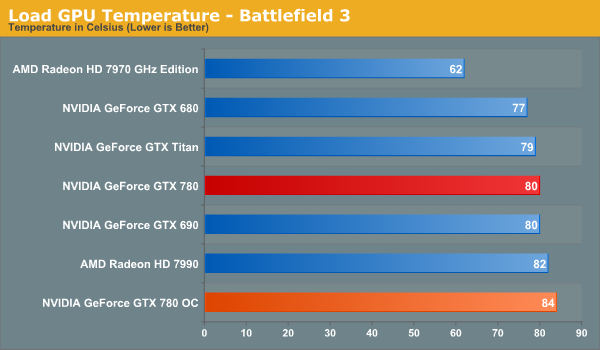
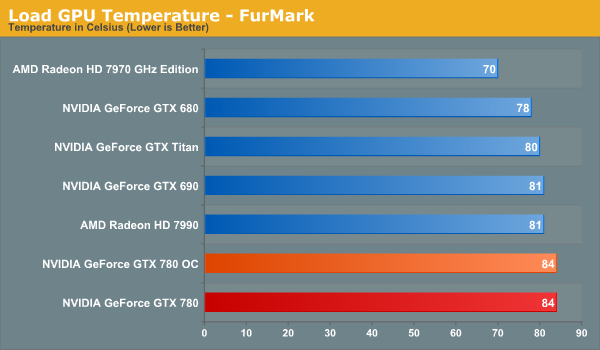
As for load temperatures, these top out at 84C. The temperature throttle itself stands at 95C, but between TDP throttling and the fan curve, the default programming of the GTX 780 keeps it at 84C in this case.

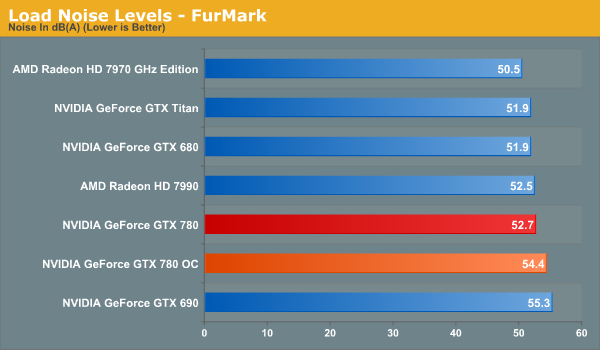
Finally, as to be expected from our power numbers, the noise cost of overclocking is equally expensive. The change under FurMark is under 2dB, but with BF3 the noise increase is over 6dB, from 48.1dB to 54.4dB. Note that this is with the GTX 780’s default fan curve, and moving the curve would allow us to reduce fan noise in exchange for higher temperatures. But at the same time the leakage effect would reduce performance a bit (we’re already TDP limited) and we’d be pushing GTX 780 to the high 80s or higher.
Wrapping things up, when it comes to overclocking the GTX 780 we’re looking at a 17% average performance improvement for a 55W increase in at-the-wall power consumption and 6.3dB increase in noise. This is enough to not only equalize GTX 780 and GTX Titan, but is enough to push GTX 780 ahead by 6% in all of our benchmarks at 2560. Whether it’s worth it is ultimately an individual decision, but in general this is a fairly reasonable tradeoff, especially if the additional noise isn’t a great concern.










39 Comments
View All Comments
mayankleoboy1 - Tuesday, May 28, 2013 - link
The FPS improvements in games are astonishing.Rick83 - Tuesday, May 28, 2013 - link
This validates pretty much what everyone expected: Titan is so direly TDP-limited, that GTX780 will perform exactly the same at a given TDP, rendering the over 9000 dollar card equal to the slightly more pedestrian (if still obscenely priced) GTX 780. The only thing that splits the two are the disabled DP-units, which probably give GTX 780 a gaming advantage, when both cards operate at the TDP limit.I hope all (non-home-HPC) Titan buyers enjoyed their 10 weeks of owning the fastest GPU in the world....Titan surely was nV's marketing coup of the decade.
tipoo - Tuesday, May 28, 2013 - link
The 780 still has 1/24th DP performance though, people who bought the Titan strictly for gaming had more money than sense and they'll be fine, but the 780 won't surpass the Titan in what it excels at. The next uncrippled CUDA compatible card up is 2400 dollars, compared to "merely" 1000.This Guy - Wednesday, May 29, 2013 - link
680's in SLI didn't cut it for a few blokes running 2560x1440 @120Hz. Titan SLI did. This is a kick in their pants.TheMan876 - Wednesday, May 29, 2013 - link
Wait... there are 2560x1440 120hz monitors??karthvader11512 - Saturday, June 1, 2013 - link
yes most 27" monitors are this resolution.theguardianlegend - Thursday, July 18, 2013 - link
This is incorrect. Most 27" monitors have a resolution of 1920 x 1080, or 1920 x 1200. And most 27" monitors certainly don't run at 120hz-- in fact, most monitors, in general, run at 60hz.theguardianlegend - Thursday, July 18, 2013 - link
Yes, but not many. They're starting to catch on. My understanding is that most of the panels used for these monitors come from Korea, at the moment. The only US based company that I've seen producing a monitor like this is Overlord Computer, and you can check them out at overlordcomputer.com. There have been more than a handful of people that swear by their Catleap 2b monitors, which run at this resolution, and can be overclocked to anywhere between 110 to 130hz.mayankleoboy1 - Tuesday, May 28, 2013 - link
By "TDP limited" , you mean that the chip can consume more power for perf, but is artificially limited by Nvidia to fit in their vision of a "good boy card" ?AndyAut - Thursday, May 30, 2013 - link
Not sure you worked with both cards. I use 2x780, 4xTitan and 4x7970GE for folding and will add 2 superclocked 780s next week (they are hard to get right now). Neither the Titan nor the 780 is in most cases TDP bound, but rather temperature bound.Both, 780 and Titan can run Stanford's most recent folding software at 1175 MHz (in my case) and still be below 60 degree Celsius. By and large, in computational intensive workloads the performance of the two cards are proportionally to the number of SMX units apart (12 vs. 14) - as long as the application uses single precision.
Some numbers:
with work unit 7663, my dual GPU systems produce: (all GPUs are in identical base systems)
Titan: 330.000 ppd (440 watt at wall outlet)
780: 280.000 ppd (430 watt)
7970 GE: 200.000 ppd (380 watt)
Dual Titan's are capable of 400.000 PPD with the recent work unit 8900 - which is computationally more efficient, but taxes power consumption a bit more (+25 watt per GPU)